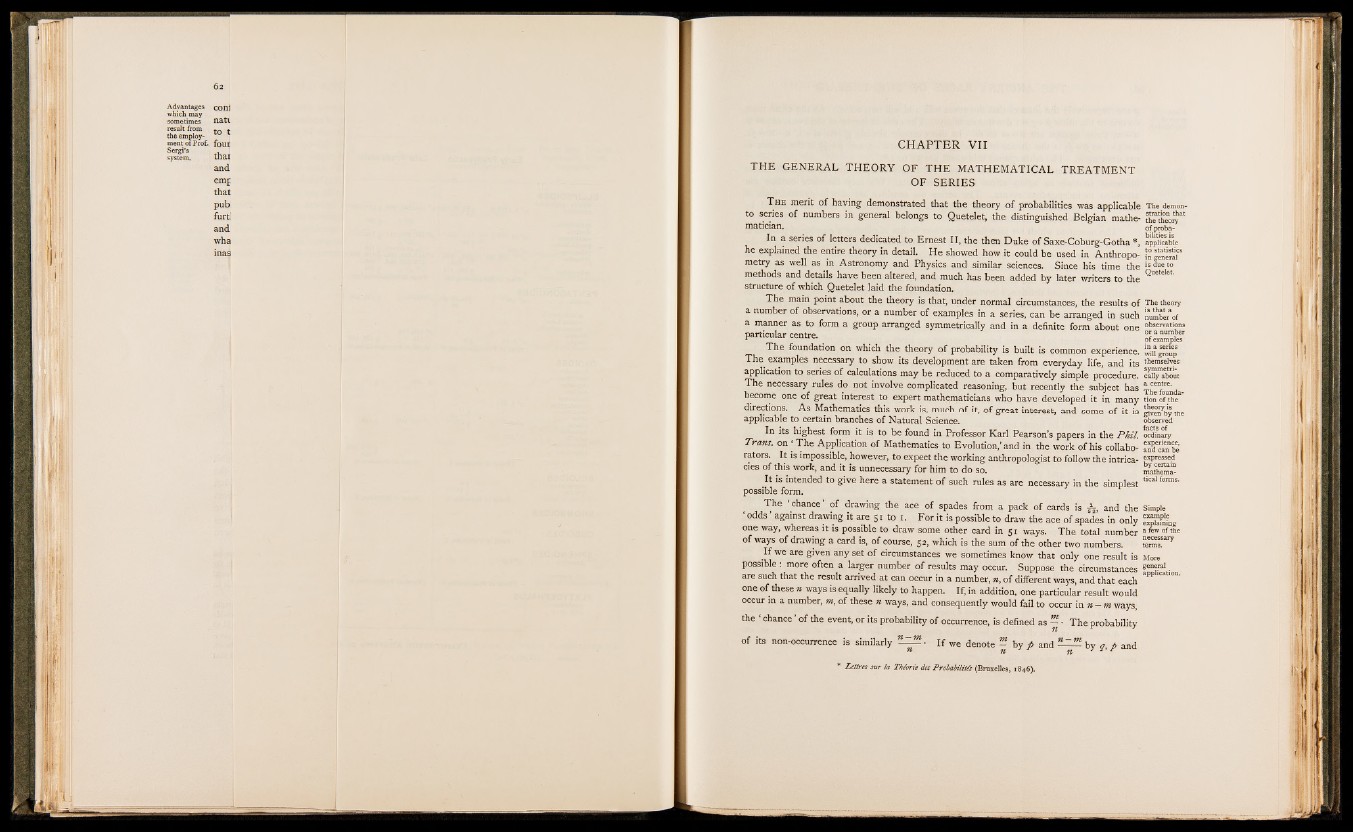
CH A P T E R V II
THE GENERAL THEO RY OF TH E MATHEMATICAL TREATMENT
OF SERIES
T he merit of having demonstrated that the theory of probabilities was applicable The demon-
to series of numbers in general belongs to Quetelet, the distinguished Belgian mathe- S ? '
maticia.ii. 0f proba-
In a series of letters dedicated to Ernest II, the then Duke of Saxe-Coburg-Gotha *, appiiïbie
he explained the entire theory in detail. He showed how it could be used in Anthropo- [° “ »“ 1“
metry as well as in Astronomy and Physics and similar sciences. Since his time the 's due to
methods and details have been altered, and much has been added by later writers to the Q“etele''
structure of which Quetelet laid the foundation.
The main point about the theory is that, under normal circumstances, the results of The theory
a number of observations, or a number of examples in a series, can be arranged in such numbe^of
a manner as to form a group arranged symmetrically and in a definite form about one observali™s
particular centre.
The foundation on which the theory of probability is built is common experience.
The examples necessary to show its development are taken from everyday life, and its ttamsehres
application to series of calculations may be reduced to a comparatively simple procedure.
The necessary rules do not involve complicated reasoning, but recently the subject has a centre'
become one of great interest to expert mathematicians who have developed it in many tio n o T th t
directions. As Mathematics this work is, much of it, of great interest, and some of it is J “ 7by the
applicable to certain branches of Natural Science. observed
In its highest form it is to be found in Professor Karl Pearson’s papers in the Ph il. S-dinïy
Trans, on - The Application of Mathematics to Evolution,'and in the work of his collabo-
rators. It is impossible, however, to expect the working anthropologist to follow the intrica- “ Pressed
cies of this work, and it is unnecessary for him to do so. maS™
It is intended to give here a statement of such rules as are necessary in the simplest ticaIfolms-
possible form.
The ‘ chance’ of drawing the ace of spades from a pack of cards is yj, and the Staple
‘ odds ’ against drawing it are 51 to 1. For it is possible to draw the ace of spades in only
one way, whereas it is possible to draw some other card in 51 ways. The total number afewofthe
of ways of drawing a card is, of course, 52, which is the sum of the other two numbers. S T “T
I f we are given any set of circumstances we sometimes know that only one result is More
possible : more often a larger number of results may occur. Suppose the circumstances geӔral.
are such that the result arrived at can occur in a number, », of different ways, and that each “PP 'Ca,,°n'
one o f these » ways is equally likely to happen. If, in addition, one particular result would
occur in a number, m, of these « ways, and consequently would fail to occur in n — m ways,
the ‘ chance ’ of the event, or its probability of occurrence, is defined as “ • The probability
of its non-occurrence is similarly • If we denote - by t and by n è and
n n n J r
* L ettres su r la Théorie des P ro b a b ilités (Bruxelles, 1846).